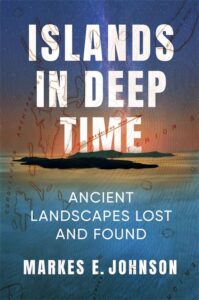By Markes E Johnson

I approached this book with a bit of scepticism and what turned out to be some completely irrelevant preconceptions. Most of the work I have read on islands in deep time revolve around matters such as the dwarf/gigantic forms that animals and can evolve into on islands with scarce resources (think Homo floresiensis or the strange dinosaurs and pterosaurs of the late Cretaceous island of Romania’s Hateg region).
I was very wrong. However, before stating why, it’s best first to explain what the book really is about, in the author’s own words.
That is, what are paleoislands?
As Markes E Johnson writes:
Paleoislands are fossil islands that reflect physical and biological conditions pertaining to ecosystems that functioned during the geologic past as microcosms largely isolated from the greater worlds around them. They are time capsules that allow the visitor to experience conditions as they were at different stages in the evolution of Plant Earth. … Former shorelines, particularly those that may be traced around ancient islands, are not such a rare curiosity as might be expected. Anyone who can learn to read a geologic map and understand the pattern of older rocks encircled by younger marine strata may set out to locate and explore paleoislands on their own account.
In fact, this is a little geological tour de force describing field locations and, what one reviewer described as:
the logic of geology: how vanished land – and seascapes can be conjured back into existence from the raw rock record”.
More particularly, the guide covers:
- Hilltops surrounded by farmland in southern Wisconsin that are the eroded remnants of an ancient archipelago;
- a Korean tourist island in the Yellow Sea, that is the peak of a flooded mountain rising from a drowned continental shelf;
- a shrine to Genghis Khan in Inner Mongolia, from where the silhouette of a Silurian coastline can be viewed; and
- a tropical coastline encrusted with corals that are nearly 450 million years old, which is found on the Hudson Bay shoreline.
Actually, Johnson covers a dozen examples, which he refers to using the geological term, monadnock (that is, an isolated rocky hill, ridge or small mountain, rising abruptly from a gently sloping or virtually level surrounding plain), which is named after the first of his examples, Mount Monadnock, in New Hampshire.
He is able to view and describe these from multiple perspectives. In so doing, he reconstructs how “palaeoislands” appeared under different climatic conditions (for example, hurricanes) and environmental constraints (as displayed by the palaeoflora and fauna of the former beach and shallow seas, now found as fossils). He thereby provides his readers effectively with a travelogue through deep time to explain the geological traces of ancient islands. And he shows how anyone with an interest in geology can begin to construct the former existence of an island.
Markes E Johnson is the Charles L MacMillan Professor of Natural Science Emeritus at Williams College. His most recent book (2021) is Baja California’s Coastal Landscapes Revealed: Excursions in Geologic Time and Climate Change.
Islands in Deep Time: Ancient Landscapes Lost and Found, by Markes E Johnson, Columbia University Press, New York (2023), 312 pages (paperback), ISBN: 978-0231212182.


